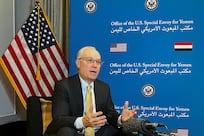Over the years, the UAE has undergone a process of dramatic transformation yet has succeeded in doing so without the trauma of social or political instability.
Although many of my younger acquaintances may think that I have been a resident of Abu Dhabi since the city was founded 250 years ago, it is a mere 36 years since I arrived. I missed what today seems like a great privilege: being here on December 2, 1971 when the UAE federation was formally established.
It was not until the summer of 1975 when I first learnt about the UAE while producing a film for Abu Dhabi television about a state visit by Sheikh Zayed to Paris. I came to the UAE for the first time later that year.
Like many people, I know about the days before the federation from the stories and old photographs that present such a contrast to what we see today. There are also remarkable differences between late 1975 and now. There was one road between Abu Dhabi and Dubai and the Northern Emirates, while the first tarmac road to Fujairah and the east coast was still under construction.
Arish huts of palm fronds were common in remoter areas. West from Abu Dhabi to Jebel Dhanna, there was only a well-beaten track and journeys to the onshore oilfields were generally made by plane.
The border control point at Seih Shuaib, two thirds of the way from Abu Dhabi to Dubai, was still standing, although no longer operational. Abu Dhabi airport was on the island but still out of town and it seemed such a long way to drive. The present airport opened only in the early 1980s.
To the south-west of Dubai Airport, beyond the yet-to-be-built World Trade Centre, there was nothing but scrub, a few small houses and the camp of the Dubai Defence Force: no Sheikh Zayed Road, no skyscrapers, not even Jebel Ali Port, whose construction had not yet begun. Power cuts were frequent and malls non-existent.
The lack of good roads meant that journeys within the UAE could take three times longer than they do today. There was a real sense that, although the UAE was a single country, unity was something that physically and psychologically had not been fully established.
There were signs, of course, that a process of change was under way. After the October War of 1973, Abu Dhabi's revenues had increased dramatically as the price of oil rose and a massive programme of construction began. I remember standing on top of a building in Abu Dhabi's Tourist Club area and counting the cranes hard at work. I got to 100 and stopped before I had counted even half.
National Days were different also. In 1976, the last military parade took place along Abu Dhabi's Corniche, past a small stand with Sheikh Zayed proudly receiving salutes as people almost within touching distance took photographs.
The population was much smaller, of course, both in Abu Dhabi and in the country, and there was a greater sense of intimacy and familiarity. There was also more interaction between the various communities.
Although it has been fascinating to observe the country's development, I miss that intimacy. In those days, residents lived in what were effectively small towns and villages while today most of us live in large conurbations, including some of the world's most modern cities.
This National Day, I look forward with optimism to the continued development that lies ahead, but I shall also look back fondly to the past and how, under the visionary leadership of Sheikh Zayed, the UAE became a country of which it is so easy to be proud.
Peter Hellyer is a consultant specialising in the UAE's history and culture





